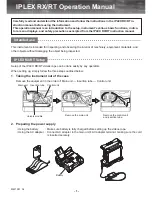
Thank you for purchasing a Sky
Quality Meter (SQM) from
Unihedron!
Features
The SQM has the following features:
It is sensitive only to visual light
(there is a near-infrared blocking
filter in front of the sensor).
The effects of temperature on the
“dark frequency" of the sensor are
removed.
The effects of temperature on the
microcontroller oscillator are
removed.
It is protected against accidental
reversal of battery polarity.
Each SQM is calibrated using a NIST-
traceable light meter. The absolute
precision of each meter is believed to
be ±10% (±0.10 mag/arcsec²). The
difference in zeropoint between each
calibrated SQM is typically ±10%
(±0.10 mag/sq arcsec)
The brightness of the numeric LED
display has two (automatic) settings.
Under dark skies, you won't have your
dark adaption ruined by use of your
SQM! Under urban skies, the display
will be correspondingly brighter.
A repeating audible beep indicates
when a measurement is in progress.
Any kind of 9V battery is usable. The
SQM contains a voltage regulator to
power the sensor, microcontroller and
other components.
After reading is taken and displayed,
the meter automatically turns itself off.
The Half Width Half Maximum
(HWHM) of the angular sensitivity is
~42°.
The unit operates from a 9V battery.
Size: 3.8 x 2.4 x 1 in. (97 x 61 x 25mm)
Maximum light sampling time: 80
seconds.
✳ ✵ ✳
Quick Start
The SQM is very simple to use. Point the
SQM so that sensor/faceplate points
toward the zenith. Press the red button
once and release. Under urban skies, a
reading will be displayed almost
immediately. Under the very darkest
conditions (no moon in the sky, far from
civilization) the SQM may take up to a
minute to complete its measurement.
Please ensure that you maintain the
orientation of the SQM until the reading is
displayed.
The SQM's reading is indicative of the sky
brightness with a cone of half-angle 40
degrees centered on the faceplate
perpendicular. There must be no direct
illumination of the faceplate sensor by a
terrestrial light source if the reading is to
be meaningful.
✳ ✵ ✳
Typical Readings
Magnitudes per square arcsecond is a
logarithmic measurement. Therefore large
changes in sky brightness correspond to
relatively small numerical changes. A
difference of 1 magnitude is defined to be
a factor of (100)
(1/5)
in received photons.
Therefore a sky brightness 5.0
mag/arcsec² fainter corresponds to a
reduction in photon arrival rate of a factor
of 100.
The following schematic gives a rough
idea of of how to interpret the readings:
At the darkest sites, natural variations in
conditions such as airglow and the
brightness of the zodiacal light are
limiting factors.
✳ ✵ ✳
Temperature reading
The temperature in °C then °F are
displayed when you press and hold the
button a second time. Also, the model and
serial number are displayed after the
temperature.
✳ ✵ ✳
Care of your SQM
The SQM is a fairly simple and robust
device. Avoid dropping, immersing, and
compressing it and it will give you years
of dependable service. Keep the faceplate
clean and ensure that the battery still has
useful capacity. If you have left your SQM
for a long period of time (i.e. years) and
see a white, powdery substance around
one of the battery contacts, your battery
will need to be replaced and the contacts
cleaned before you can expect reliable
operation.
The SQM should not be negatively
affected by dew during normal operation
EXCEPT for the reduction in received
light by the sensor. Make sure that the
sensor faceplate has been wiped before
making measurements.
During storage, make sure that the push-
button is not being continuously pressed
since the meter will draw current from the
battery and drain it in that situation.
✳ ✵ ✳




















